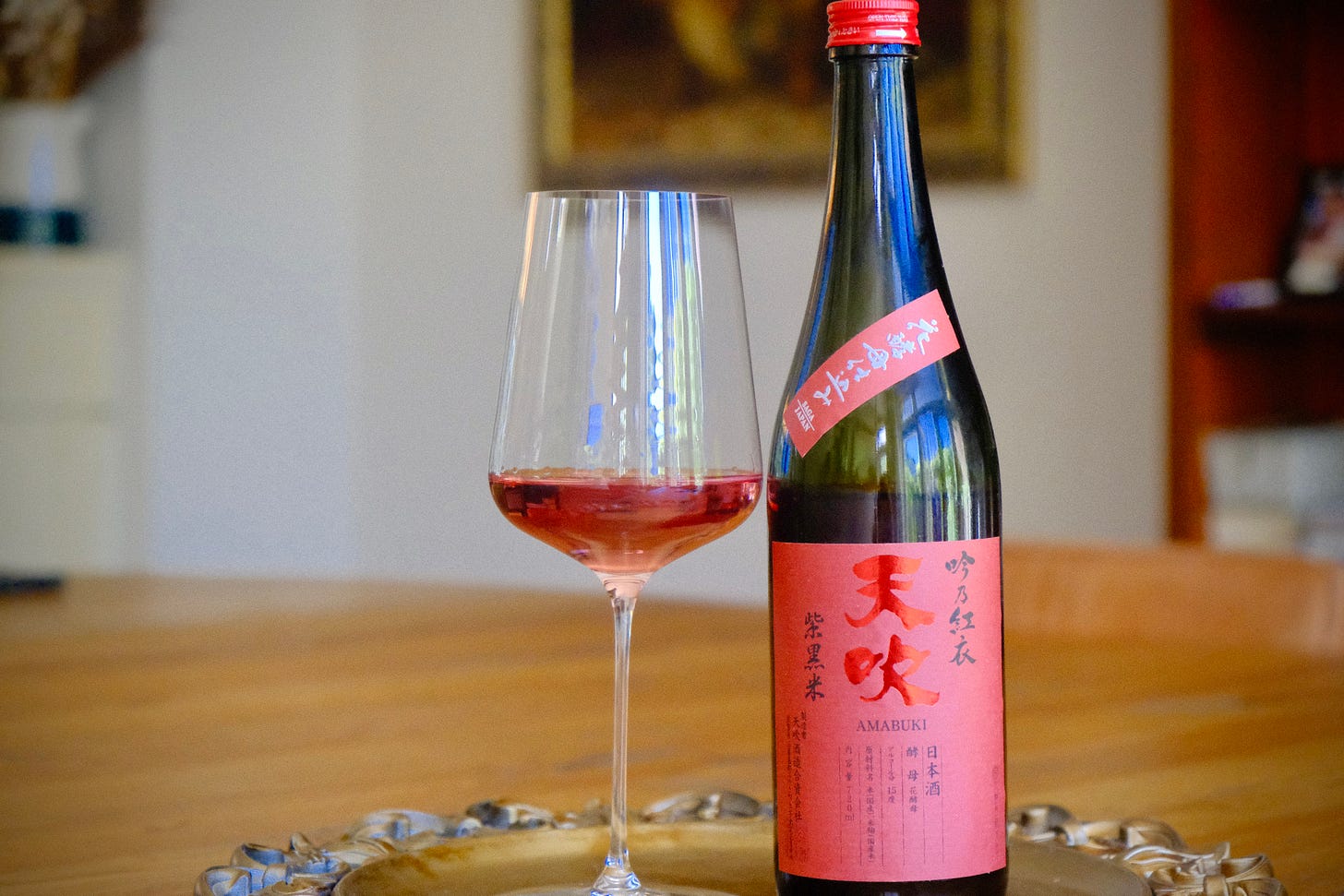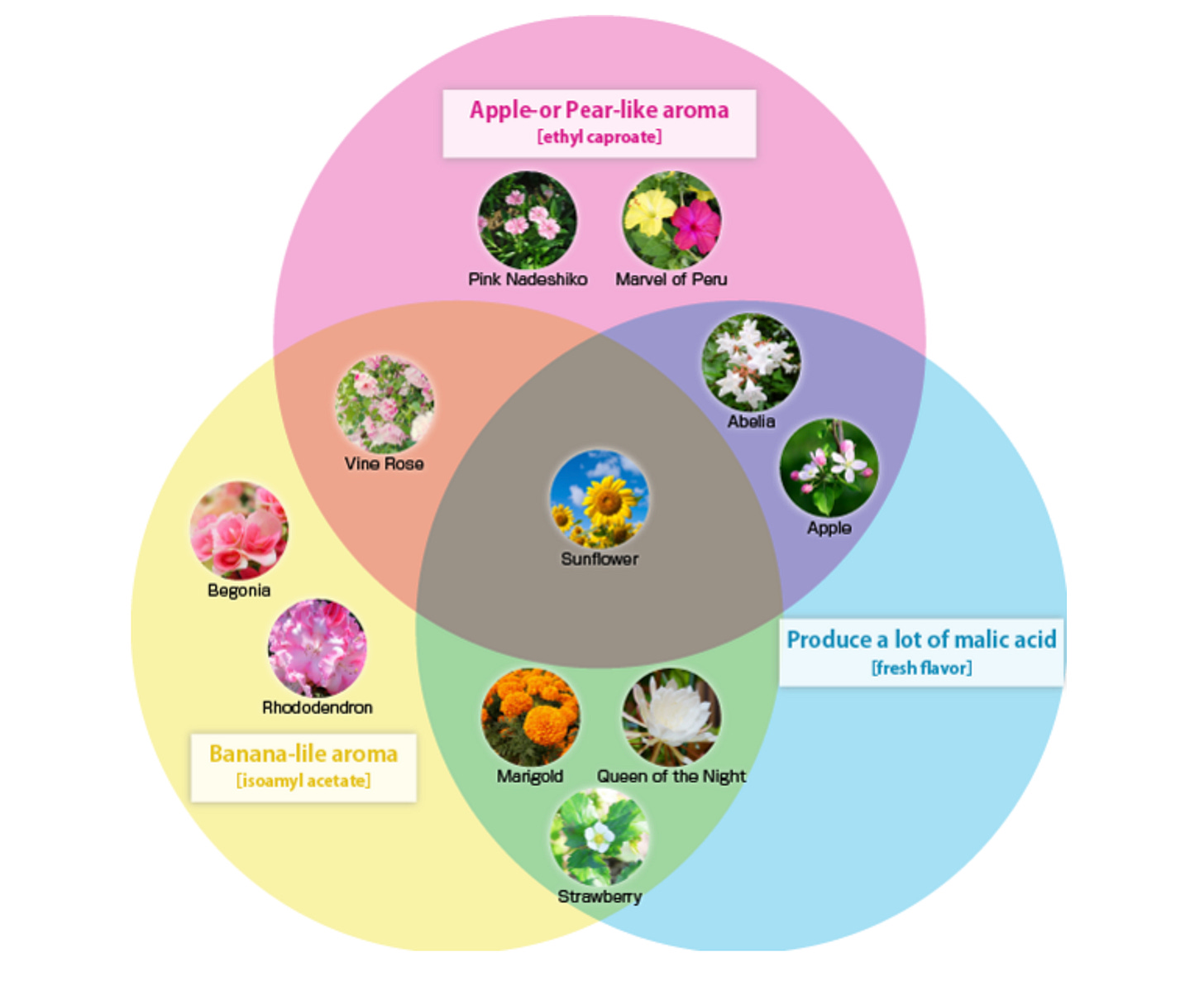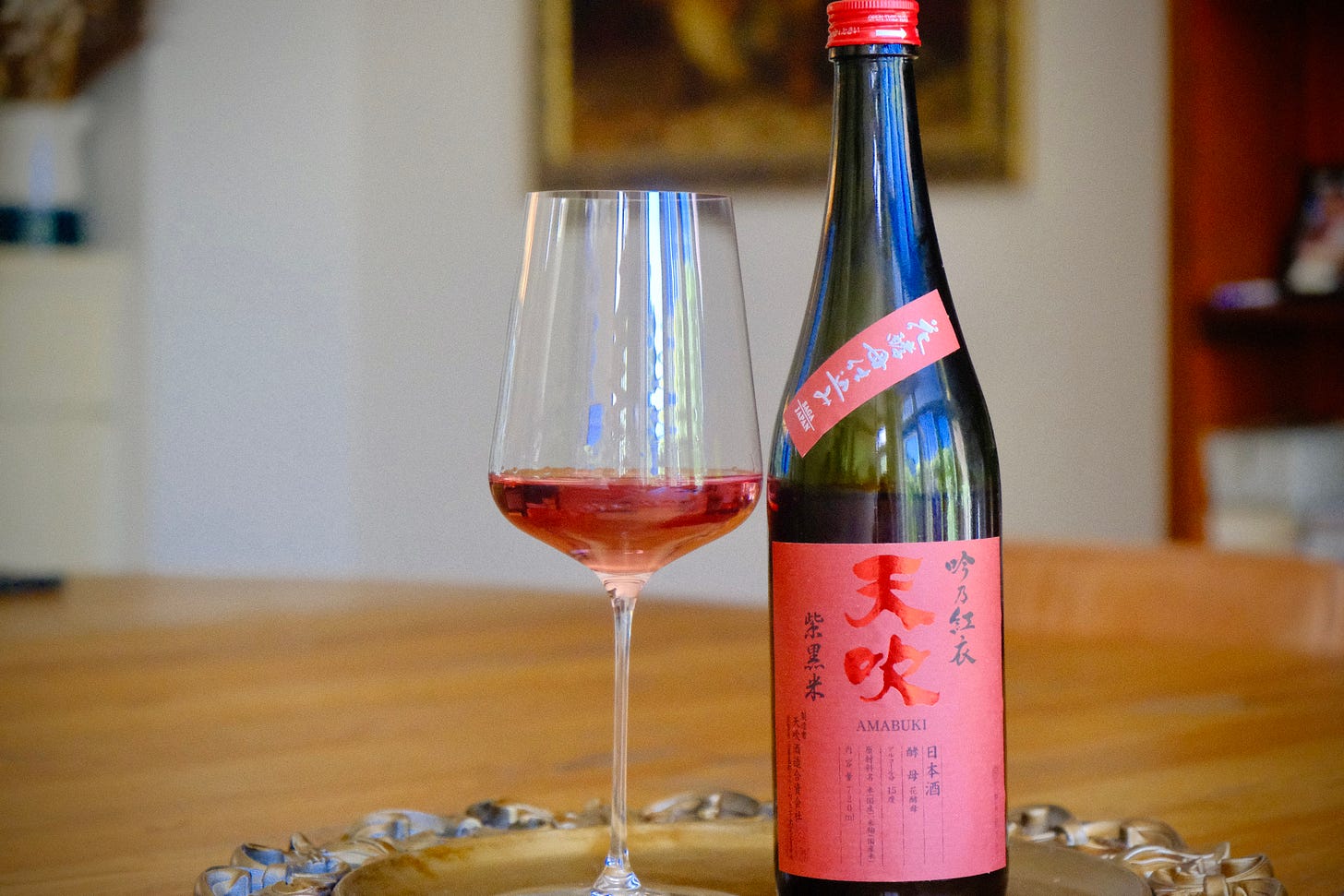Sake 101 #8: Understanding Rosé Sake
Behind the glass: a deep dive into pink sake, flower yeasts, and a poetic pairing
📍Who This Is For
If you’re a wine professional—or a serious enthusiast who wants to talk about sake the way you talk about wine—this post is for you.
Whether you’re guiding customers, hosting tastings at home, or just exploring premium bottles with intention, this series will help you translate sake into the language of wine.
I’m Kazumi, a wine and sake educator based in Amsterdam, with DipWSET. With a background in both Japanese and European food cultures, I write this Sake 101 series every Tuesday to bridge the gap—translating sake into the language of wine.
This week’s theme: the world of rosé sake—how it’s made, how it tastes, and how to pair it beautifully.
What Is Rosé Sake, Really?
Rosé wine isn’t just a drink—it’s a mood.
It conjures images of Provence in summer: sun-dappled terraces, linen shirts, chilled glasses of pale pink wine, and long, easy afternoons. From beachside brunches to elegant rooftop dinners, rosé sets the tone.
Over time, it has become a global lifestyle symbol—effortless, lighthearted, and visually stunning. It’s no surprise that celebrities like Brad Pitt (Château Miraval) and George Lucas (Château Margüi) have invested in Provence estates. Even people who rarely drink wine know: rosé means sunshine, freshness, and fun.
But can sake—Japan’s national drink—capture that same energy?
That’s where rosé sake comes in.
Though not an official category under sake law, the term rosé sake is now used internationally to describe Japanese sakes that are naturally pink—ranging from delicate blush to vibrant ruby. These eye-catching colors aren’t artificial; they result from special brewing techniques, such as using ancient black rice or unique yeasts.
While the technical ability to brew pink sake has been around since the early 2000s, it wasn’t until Western wine lovers began to take notice—drawn by both the aesthetics and the flavor—that rosé sake gained international attention. The term itself was a reverse import: coined abroad, and only later embraced in Japan.
How Does Sake Turn Pink?
Unlike rosé wine, which gets its color from brief skin contact with red grapes, rosé sake derives its hue from other natural sources. No additives or artificial colorants are used. Instead, the pink color emerges from the ingredients themselves and the brewer’s technique. Here are the three primary methods used to create rosé sake.
Using Ancient Black Rice
Some rosé sakes are made with black or red rice, heritage varieties rich in natural pigments such as anthocyanins—the same compounds that give blueberries and red cabbage their color. During fermentation, these pigments gradually infuse the sake with a soft pink to reddish tint. This method tends to yield sake that is gently sweet and mellow, sometimes with earthy or grain-like undertones.Using Red Yeast
Another technique involves red-colored yeast strains. According to the Brewing Society of Japan, which standardizes and distributes sake yeast, this particular yeast is difficult to handle—it ferments very slowly, and its color fades easily—making it typically suitable only for nigori-style(unfilitered) sake. However, some innovative producers, such as Takizawa Shuzo in Saitama Prefecture, have succeeded in using red yeast to create sparkling rosé sake with vivid color and soft acidity.Using Red Koji
Red koji (Monascus purpureus) has been used for centuries in China, Taiwan, and Japan to make fermented foods and vinegar. In sake brewing, red koji refers to a well-studied mold strain known to be safe for use in food fermentation. Today, several low-alcohol, naturally pink sakes are made using red koji. These sakes often combine gentle acidity with soft sweetness and a naturally rosy hue—no artificial coloring needed.
Let’s take a closer look—through one remarkable bottle.
A Rosé Sake to Know: Gin no Kurenai (Amabuki Shuzo)
The sake: Gin no Kurenai
Gin no Kurenai is a naturally pink junmai sake brewed with ancient black rice. It is made using a ginjo-style approach—pure rice, no added alcohol, 65% polishing ratio, and low-temperature fermentation to highlight fruity and elegant aromas. Because black rice is not approved for official use in ginjo-designated sakes, the word “ginjo” cannot appear on the label, even if the production method qualifies.
Tasting notes
In the glass, it shows a soft ruby pink that immediately catches the eye. On the nose, crisp, restrained notes of strawberry, raspberry, rhubarb, and rose petal—reminiscent of truly rosé wine—are layered with restrained ginjo-style aromas of green apple. Subtle hints of yogurt and fresh herbs add dimension and freshness.
The palate is serious sake. Almost dry with slight residual sugar, having a smooth texture and a well-balanced structure. Relatively high acidity, gentle umami, and a touch of bitterness give it a refined, food-friendly character. The finish is clean, satisfying long, and lightly tart, making it especially well-suited to fresh cheeses or spring vegetables.
This sake is best served chilled in a wine glass, where its pale hue and aromatic lift can be fully appreciated. Though often positioned as an aperitif, it also pairs beautifully with light dishes thanks to its refreshing balance.
The brewery: Amabuki Shuzo
Amabuki Shuzo, located in Saga Prefecture, is known as one of Japan’s most forward-thinking breweries, especially for its pioneering use of flower yeasts. Since the early 2000s, the brewery has explored how different blossoms—such as strawberry, begonia, marigold, and queen of the night—can impart unique fermentation profiles and aromas to sake.
The origins of this innovation trace back to Tokyo University of Agriculture, where the current master brewery began studying wild yeast strains. Yeast naturally lives in soil, and historically, airborne soil particles brought yeast into breweries, settling on beams and walls. This became known as house yeast. Later, researchers realized that yeast is drawn to sugars—leading them to flower nectar, which proved rich in wild yeast. From these blossoms, viable sake yeasts were successfully isolated.
As the brewery explains on its official website, each flower yeast brings its own aroma signature and fermentation behavior. This approach to yeast diversity allows Amabuki to produce sake that is not only expressive but also highly individual—something that resonates with wine lovers who appreciate nuance and complexity.
With its vivid hue, aromatic lift, and delicate sweetness, Gin no Kurenai offers more than just a pretty pour. It’s a genuine expression of Amabuki’s philosophy: brewing sake that surprises, delights, and reflects the biodiversity of Japan’s natural world.
A Taste Spring: Pairing Gin no Kurenai with Strawberries and Burrata
Some bottles don’t just pair with food—they inspire a dish. The moment I opened Gin no Kurenai, its soft ruby hue and delicate aromas of strawberry, rhubarb, rose petals and a hint of dairy notes immediately brought one thing to mind: a plate of fresh strawberries with burrata and prosciutto.
It’s a combination that plays with contrast. The sweetness and acidity of ripe strawberries echo the wine-like tartness of the sake. The creamy richness of burrata softens the dryness on the palate, while prosciutto adds a touch of salt and umami to highlight the sake’s structure. A drizzle of olive oil, a twist of black pepper, and perhaps a basil leaf complete the picture.
Served on a terrace in the late afternoon sun, this pairing becomes more than just food and drink—it becomes a scene. One where Japan’s fermentation traditions meet Mediterranean delight, where sake lovers and wine drinkers find common ground in a glass of pink.
Thanks for reading Pairing the World: Wine, Sake, and More! If you find my work valuable, you can support me by liking, commenting, stacking, or subscribing.
Sake 101: 春のグラス – ロゼ日本酒の魅力
花酵母や黒米が生み出す、軽やかで奥行きのある世界。ロゼ酒の醸造法、香り、ペアリング
📍この投稿の意図
オランダ・アムステルダム在住の日本酒とワインの講師、Kazumi(DipWSET)です。
この投稿は、海外のワインのプロフェッショナル——たとえば、ワインショップのスタッフ、ソムリエ、ワインエデュケーターといった方々に、日本酒の魅力をもっと知ってもらいたいという思いから執筆しています。
日本とヨーロッパ、両方の食文化を背景に、
「日本酒やワインの魅力を自分の言葉で伝えられるようになりたい」
「日本と海外の架け橋になりたい」
そんな願いを込めて、毎週英語で発信しています。
この日本語訳は、その取り組みを日本の皆さまに知っていただくために添えています。
もしこの活動が、日本酒に関わる皆さまにとって「応援したくなる取り組み」だと感じていただけたら、とても嬉しく思います。
今回のテーマは、「ロゼの日本酒」。
その美しさ、造り方、そして一皿との出会いについて綴りました。
ロゼって、ただの飲みもの?
ロゼワインは、ただのワインではありません。
それは、ひとつの「気分」や「季節感」、あるいは「ライフスタイルの象徴」として世界中に広まりました。
たとえば、南仏プロヴァンスの夏。
日差しが差し込むテラス、リネンのシャツ、淡いピンクのワインが注がれたグラス。ビーチサイドのブランチや、屋上でのディナー。そんなゆったりした午後の光景を思い出させてくれます。
俳優のブラッド・ピット(Château Miraval)やジョージ・ルーカス(Château Margüi)がロゼワインのワイナリーに投資したのも、そんな世界観を体現したかったからかもしれません。ロゼ=「陽の光と楽しさ」。そのイメージは今や世界共通です。
でも、日本酒にも、そんな「ロゼの気分」を表現することができるのでしょうか?
ロゼ酒とは何か?
ここ数年、「ロゼ酒」という言葉が海外を中心に使われるようになってきました。
淡いピンクからルビー色まで、色とりどりの日本酒。その美しさは人工的な着色ではなく、*古代米(黒米・赤米)や特殊な酵母(赤色酵母・花酵母)、紅麹によって自然に生まれるものです。
日本では2000年代初頭から、こうしたピンク色の酒の醸造技術が実験的に進められてきましたが、本格的に注目されたのは、欧米のワイン愛好家たちがその美しさと味わいに魅了された頃から。「Rosé Sake(ロゼ酒)」という言葉自体も、実は海外で生まれ、日本に“逆輸入”される形で広まりました。
どうやってお酒がピンク色に?
ロゼ酒の主な3つの製法を見てみましょう。
1. 古代米(黒米・赤米)を使う
ピンク色の日本酒の多くは、ブルーベリーや紫キャベツにも含まれるアントシアニンという天然色素を含む古代米を使用します。
発酵の過程でこの色素が酒にじわじわと移り、淡いピンクから深いルビー色に。
味わいはやや甘やかで、穏やかな酸、ほのかな穀物感や土っぽさが感じられることもあり、ナチュラルワインにも通じる印象を持つ酒もあります。
2. 赤色酵母を使う
もう一つの方法は、赤い色を出す酵母を使うこと。
日本醸造協会によれば、赤色酵母は発酵が非常にゆっくりで、色も抜けやすいため「にごり酒(濁り酒)」など限られたスタイルに適しているとされています。
それでも埼玉の滝澤酒造のように、工夫を重ねてスパークリングタイプのロゼ酒をつくる蔵も出てきています。
3. 紅麹(べにこうじ)を使う
中国・台湾・日本などで古くから発酵食品や赤酢の原料として使われてきた紅麹。日本酒の世界では、「モナスカス・プルプレウス(Monascus purpureus)」という安全性の高い紅麹菌を用いて、自然なピンク色のお酒を造る動きがあります。
近年では低アルコールで優しい酸味をもつロゼ酒が、この製法でいくつも誕生しています。
では実際、どんな味がするのか?今回は、そんなロゼ酒の中から1本をご紹介します。
印象的なロゼ酒: Gin no Kurenai(天吹酒造)
このお酒について
「Gin no Kurenai(吟乃紅衣)」は、黒米で造られるナチュラルピンクの純米酒です。
醸造スタイルは“吟醸的”とも言えるアプローチ——つまり、純米仕込みで、アルコールの添加なし、精米歩合は65%、低温でじっくりと発酵させ、果実のような香りとエレガンスを引き出しています。
ただし、黒米は酒税法上「吟醸酒」の原料として正式に認められていないため、たとえ製法が吟醸スタイルであっても、ラベルには「吟醸」とは記載できません。
テイスティングノート
グラスに注ぐと、まず目を引くのはその淡く艶のあるルビーピンク。
香りには、いちごやラズベリー、ルバーブ、バラの花びらといった、まさにロゼワインを思わせるようなニュアンスが漂います。さらに、青リンゴを思わせる控えめな吟醸香や、ほのかなヨーグルトやハーブのニュアンスも重なり、奥行きを感じさせてくれます。
口に含むと、印象はきりっとドライ寄り。控えめながら糖分がまろやかな質感を与え、しなやかで調和のとれたバランスに仕上がっています。比較的しっかりとした酸味、やさしいうま味、最後にかすかに感じる苦味が、料理との相性を広げてくれるでしょう。
後味はクリーンで繊細、余韻にはかすかな酸が残り、フレッシュチーズや春野菜とのペアリングにぴったりです。
このお酒は、冷やしてワイングラスで楽しむのがおすすめ。
その色合いと香りの広がりを最大限に楽しむことができます。
アペリティフとしてはもちろん、軽めの前菜とも美しく調和します。
蔵元紹介:天吹酒造(佐賀県)
天吹酒造(あまぶきしゅぞう)は、佐賀県にあり、革新的な酒蔵として知られています。
特に注目されているのは、2000年代初頭から続く、花酵母(はなこうぼ)を使った酒造りへの取り組みです。
いちご、ベゴニア、マリーゴールド、月下美人など——さまざまな花から分離された酵母は、それぞれ異なる香りの個性や発酵特性を持ちます。天吹酒造は、それを活かして、一本一本の酒に違った「表情」や「香りの輪郭」を持たせる独自のスタイルを築いてきました。
この発想の原点は、蔵元が学んでいた東京農業大学での研究にさかのぼります。
酵母はもともと土壌に存在していて、風に乗って蔵の梁や壁に付着することから「蔵付き酵母(くらつきこうぼ)」と呼ばれます。では、それらの酵母はどこから来ているのか?
そう考えた彼らは、酵母が糖分に集まりやすい性質に着目し、花の蜜の中にある野生酵母を採取・分離。そこから、日本酒の醸造に使える「花酵母」を育て上げたのです。
天吹酒造のサイトでもこう紹介されています。
花酵母は、それぞれ異なる香り成分や発酵挙動を示します。私たちは、定型的な酒造りではなく、米と酵母の組み合わせによって、バラエティに富んだ味わいのある酒を提案しています。
こうした酵母の多様性を活かす酒造りは、ワインの“テロワール”の考え方に近いものがあります。酵母=香りの個性ととらえ、それを積極的に表現する天吹のスタイルは、香りに敏感なワインラバーにとっても非常に魅力的なアプローチではないでしょうか。
この「吟乃紅衣」も、まさにその哲学を体現する一本です。
ただ美しいだけでなく、花由来の酵母と黒米という2つの個性が溶け合い、日本酒の可能性をそっと広げてくれる。そんなお酒です。
このあとは、実際にどんな料理と合わせたらより魅力が引き立つのか?
春の午後にぴったりの、印象的なペアリングアイデアをご紹介します。
春の午後に、この一皿を
吟乃紅衣 × いちごとブッラータ、生ハム添え
お酒が料理に合うことはよくありますが、時には「この酒のために料理を作りたくなる」——そんなインスピレーションをくれる一本に出会うことがあります。
吟乃紅衣 を開けた瞬間、その淡いルビーピンクの色合いと、いちごやルバーブ、バラの花びらのような繊細な香りを感じて、私の頭にぱっと浮かんだのが、いちごとブッラータ、生ハムを合わせた一皿でした。
甘酸っぱい完熟いちごは、ワインのような酸味を持つこの日本酒と響き合い、ブッラータのクリーミーさが口当たりのやわらかさを引き立てます。
生ハムの塩気と旨みが加わることで、酒にあるわずかな苦味や酸の骨格がよりくっきりと浮かび上がります。
オリーブオイルをほんの少し、黒胡椒をきゅっとひとふり。
バジルの葉を添えれば、香りの立体感も生まれ、まるで前菜として完成された一品に。
春の日差しが差し込むテラスでこのペアリングを楽しめば、それはもう単なる「食事」ではなく、ひとつのシーンになります。
日本の発酵文化と地中海のシンプルな食材が、ひとつのグラスの中で出会う時間。
ワイン好きと日本酒好きが、同じテーブルでふっと笑顔になれる。
吟乃紅衣は、そんな世界をさりげなくつなげてくれる存在です。
読んでくださってありがとうございます!
この投稿は、ワインの視点から日本酒を学ぶ「Tuesday Sake 101」シリーズの一部です。
「Pairing the World: Wine, Sake, and More!」は、ワインと日本酒の世界をつなぐブログです。
この投稿が、日本酒とワインをつなぐ新しい視点として楽しんでいただけたなら嬉しいです。応援したいと思っていただけた方は、ぜひ「いいね」や「コメント」、ご購読(Subscribe)でサポートしていただけると励みになります。🍶🍷
なお、本シリーズにてご紹介したい日本酒や、海外向けにラインナップをご紹介希望のインポーター様・酒蔵様からのご連絡もお待ちしております。








